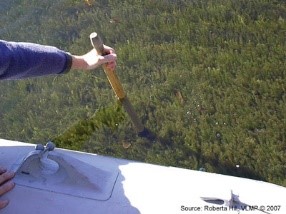Community News

Hydrilla
Description: Hydrilla is a perennial underwater aquatic plant with long slender, branching stems rising from horizontal underground. Identification of hydrilla is complicated by the fact that there are two distinct forms occurring in the United States.
Habitat: Hydrilla is found in the underwater plant community. The adaptability of this plant to a wide variety of environmental conditions has earned hydrilla its reputation as the perfect weed. Hydrilla can grow in a variety of bottom surfaces, in waters still or flowing, low or high in nutrients. Hydrilla may also threaten estuary systems, tolerating salinities up to 10 parts per thousand. Remarkably adapted to low light conditions, hydrilla can photosynthesize earlier and later in the day than most plants, grows well in murky water and, when the water is clear, to depths exceeding 10 meters. Hydrilla typically occurs in thick, rooted stands, but live pieces may also be found drifting in large mats. Hydrilla is considered one of the most problematic of all water invaders.
Annual Cycle: Hydrilla sprouts in the spring, the leafy stems grow rapidly (about 2 cm per day) toward the surface. Flowers, buds and bulb-like structures are produced during the growing season. The buds drop to the sediments when the leafy vegetation begins to break up in the fall. The plants die back completely to the sediments by early winter, a remarkable vanishing act given the amount of biomass involved. The buds will sprout the following spring, but the bulb-like structures may remain dormant for several years in the sediments. Research indicates that one bulb-like structures can lead to the production of over 5,000 new bulb-like structures per square meter. The bulb-like structures and buds can withstand ice cover, drying, ingestion by waterfowl, and herbicides. Studies also indicate that the form found in Maine, puts more of its energy into bulb-like structures and bud production than the other form, and may have a greater potential for spread by these means. In addition to reproducing like plants by way of bulb-like structures and buds, hydrilla grows readily from stem or broken root pieces. New plants can sprout from stem pieces.
Origin and U.S. Range: Hydrilla is native to Africa, Australia, and parts of Asia. The dioeciously form, found primarily in more southern latitudes, was first introduced to the US through the aquarium trade during the mid-1900s. The monoecious form, found primarily in northern latitudes, was introduced some time later and has now been confirmed in several New England states, including Pickerel Pond in Maine, Connecticut, Massachusetts and also New Jersey.
Look a likes: May be confused with Brazilian waterweed, native waterweeds, water starworts, and mare’s tail.
